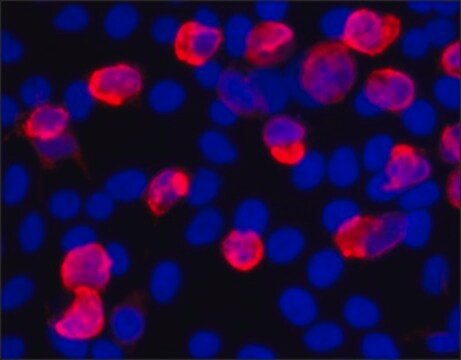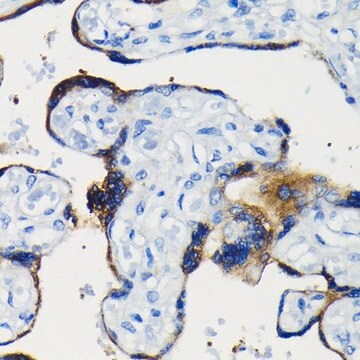MAB4349
Anti-TRA-2-49 Antibody, Liver/Bone/Kidney Alkaline Phosphatase, clone TRA-2-49/6E
clone TRA-2-49/6E, Chemicon®, from mouse
About This Item
Empfohlene Produkte
Biologische Quelle
mouse
Qualitätsniveau
Konjugat
unconjugated
Antikörperform
purified antibody
Antikörper-Produkttyp
primary antibodies
Klon
TRA-2-49/6E, monoclonal
Speziesreaktivität
rabbit, feline, pig, human
Darf nicht reagieren mit
rat, monkey, guinea pig, mouse
Hersteller/Markenname
Chemicon®
Methode(n)
flow cytometry: suitable
immunocytochemistry: suitable
immunofluorescence: suitable
immunoprecipitation (IP): suitable
Aufnahme
sample type induced pluripotent stem cell(s)
sample type: human embryonic stem cell(s)
Isotyp
IgG1
Versandbedingung
wet ice
Posttranslationale Modifikation Target
unmodified
Verwandte Kategorien
Allgemeine Beschreibung
Undifferentiated human Embryonal Carcinoma (EC) and Embryonic Stem (ES) cells have been shown to express very high levels of Alkaline Phosphatase isozyme that is indistinguishable from the isozyme found in liver, bone and kidney. Expression levels of AP decrease following stem cell differentiation. This clone can be used to monitor the expression of the Human Liver / Bone / Kidney isozyme of Alkaline Phosphatase (AP), and hence the differentiation status of human EC and ES cells by flow cytometry.
Spezifität
Immunogen
Anwendung
Stammzellforschung
Pluripotente Stammzellen & Stammzellen der frühen Entwicklungsphase
Immunofluorescence: A previous lot of this antibody was used in IF.
FACS Analysis: A starting range of 5-20 µg/mL is suggested.
Immunoprecipitation: A previous lot of this antibody was used in IP.
Optimal working dilutions must be determined by end user.
Zielbeschreibung
Physikalische Form
Lagerung und Haltbarkeit
Hinweis zur Analyse
Undifferentiated human embryonic stem cells (H9 line). NTERA-2 cl.D1 whole cell lysate (pluripotent stem cells derived from teratocarcinoma and are considered the malignant counterparts of human embryonic stem cells)
Sonstige Hinweise
Rechtliche Hinweise
Haftungsausschluss
Sie haben nicht das passende Produkt gefunden?
Probieren Sie unser Produkt-Auswahlhilfe. aus.
Lagerklassenschlüssel
10 - Combustible liquids
WGK
WGK 2
Flammpunkt (°F)
Not applicable
Flammpunkt (°C)
Not applicable
Analysenzertifikate (COA)
Suchen Sie nach Analysenzertifikate (COA), indem Sie die Lot-/Chargennummer des Produkts eingeben. Lot- und Chargennummern sind auf dem Produktetikett hinter den Wörtern ‘Lot’ oder ‘Batch’ (Lot oder Charge) zu finden.
Besitzen Sie dieses Produkt bereits?
In der Dokumentenbibliothek finden Sie die Dokumentation zu den Produkten, die Sie kürzlich erworben haben.
Unser Team von Wissenschaftlern verfügt über Erfahrung in allen Forschungsbereichen einschließlich Life Science, Materialwissenschaften, chemischer Synthese, Chromatographie, Analytik und vielen mehr..
Setzen Sie sich mit dem technischen Dienst in Verbindung.




